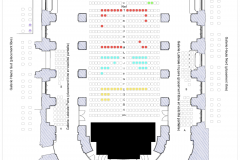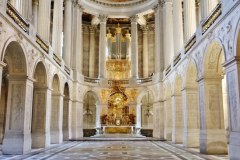Christine de Suede
Mo | Tu | We | Th | Fr | Sa | Su |
Christine de Suède | Concert
The life of Christine of Sweden seems straight out of a novel—or better yet, an opera. Born on December 18, 1626, in Stockholm, she ended her days in Rome in 1689 after an exile that led her to meet more and more protagonists throughout the different acts of her life. A great lover and patron of the arts, her life is marked by the omnipresence of music, of which she was a major supporter. This concert musically retraces her life in three acts—and a prologue—through works she might have heard or even commissioned.
Prologue: the coronation and abdication. The concert opens with a selection of works that might have been performed at her coronation—about which nothing is known musically. The highlight of this moment is Carissimi’s Veni Sponsa Christi (whom Christine admired and would meet much later). But the joyful prologue ends abruptly with Fader War, which was sung at her abdication.
The first act is set in the city of Innsbruck in 1654, when Christine was invited by Archduke Ferdinand Charles of Austria. There she affirmed her new conversion to Catholicism and attended the performance of L’Argia, an opera by the imperial composer Antonio Cesti, given in her honor. The third act is her brief stay at the French royal court in 1657. Although Lully had not yet composed his great motets, Henry Du Mont held this position at the time. The final act: Rome. Christine was then a major patron and supported many composers such as Stradella and Melani. The latter wrote a sumptuous Requiem preserved in the Santini Collection, which gathers many artistic treasures accumulated by the most European of princesses of her time.
The Productions of the Royal Opera.
Prestige VIP – Best seats in the house, including a glass of champagne and the show program.
Prestige – Includes a complimentary glass of champagne.
Program and cast
Malena Ernman, Mezzo-soprano
Maîtrise de Paris / CRR
Soloists of the Royal Opera Academy
Chœur de l’Opéra Royal
Orchestre de l’Opéra Royal
Consort Musica Vera
Jean-Baptiste Nicolas, Conductor
Programme
Christine de Suède
After André Danican Philidor (1652–1730)
La Suédoise
Gustav Düben (1629–1690)
Venite Sancte Spiritus
Giacomo Carissimi (1605–1674)
Veni Sponsa Christi
Gustav Düben
Fader War
Antonio Cesti (1623–1669)
L’Argia: prologue
Henri Du Mont (1610–1684), Michel Lambert (1610–1696) and Jean-Baptiste Lully (1632–1687)
Court airs and excerpts from Alcidiane
Alessandro Melani (1639–1703) and Antonio Bertali (1605–1669)
Requiem and excerpts from the Missa Archiducalis
Royal Chapel of Versailles
The Royal Chapel was finished in 1710 at the end of Louis XIV’s reign. Jules Hardouin-Mansart proposed the plan to the King in 1669. The First Architect died in 1708 without seeing the end of the works which were taken over by his brother-in-law Robert De Cotte. The reigning monarch only came for major religious festivals where he received communion, for ceremonies of the Order of Saint-Esprit, for the baptisms and weddings of the royal children celebrated from 1710 to 1789. This exceptional palatine chapel was also used for a wide range of religious ceremonies, including the marriage of Archduchess Marie-Antoinette with the future Louis XVI.
Above the altar, around the organ by Clicquot decorated with a fine relief of King David, played by great masters like François Couperin, the Chapel’s music, famous all over Europe, sung motets everyday during all religious services. Today Handel’s Dixit Dominus or Messiah, Bach’s Oratorios, Magnificat, Cantatas or Passions, Pergolesi’s Stabat Mater or Charpentier’s Te Deum ring out in this majestic architecture.

 EN
EN DE
DE IT
IT FR
FR ES
ES RU
RU JP
JP RO
RO
 Seating plan
Seating plan 